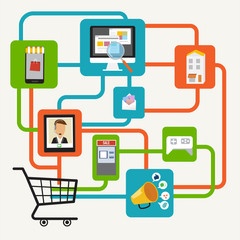One of the newest buzzwords to invade our business lexicon is “Omnichannel”. If you haven’t heard  of it yet, you surely will very soon as many organizations – especially those who are in the retail space – are embracing it as a strategy. My prediction is that within the next 10 years Omnichannel marketing along with AI-based analytics will be the core part of foundational Business Acumen IQ.
of it yet, you surely will very soon as many organizations – especially those who are in the retail space – are embracing it as a strategy. My prediction is that within the next 10 years Omnichannel marketing along with AI-based analytics will be the core part of foundational Business Acumen IQ.
If you need a definition, Omnichannel is a business strategy that enhances the customer experience by offering cross-channel, cross-platform access to products and services. In other words, an omnichannel strategy lets customers decide how they are going to receive their value proposition. Here is a simple yet provocative example. It’s time to buy a new pair of running shoes, so like most people you start with an online search and identify a couple of different models that you like but really don’t want to buy them until you try them on. You’ve been wearing Brand X, but think these new Brand Z’s look really comfortable. Knowing that you have some errands to run, you close your browser and head out to the local shops. Walking around, you walk into the local running store and see more running shoes that you like, but not that Brand Z that you liked so you leave. Later that evening, you go to the Mall for dinner and as you are checking your email, you are notified that the Brand Z store located in the Mall is offering a 20% discount for the next two hours. Obviously, this wasn’t a random group of independent events but rather a sophisticated coordinated strategy from the Brand Z company deploying an Omnichannel strategy that carefully orchestrates an integrated way of thinking about the customer’s relationship the organization.
Much more than a “multi-channel” customer experience where maybe online and offline work together, Omnichannel is about true customer continuity of experience that includes the brand’s complete ecosystem. And that ultimately is what customers want; a value proposition that presents itself wherever and whenever the customer wants to receive it. And of course, they’d love that experience to have the highest quality at the lowest possible price.
When we think about brands and we think about the customer experience, we need to start about the Omni. It’s hard to break the mental model that we’ve all grown up with; it’s now a world that goes beyond “my customers” and “their customers”, it’s a world that goes beyond “low-end customers” and “high-end customers”; it’s a world that is centered around all customers.
As the tools become more sophisticated and customers have greater expectations for omnichannel experiences, brands need to realize that the day of 50% off sales, loyalty programs, special event weekends, and colorful merchandising displays are over. Brands that are going to be successful must move quickly to utilizing the complete suite of Omnichannel tools involved in making the customer experience seamless. If you have any doubts, just look at what’s happened to the pharmaceutical industry and specifically the way they market and sell. For many companies 2018 will see for the first time in the history of the industry more money being spent on non-personal promotion and Omnichannel strategies than they are on having a live sales force. Non-personal promotion leverages social media and creates a seamless perception of a brand in the eyes of decisions makers such as payer, patients, and providers.
We all realize the profound impact the Social Media revolution has had on business and the way Brands communicate to their customers. Omnichannel is essentially the realization of Social Business. It started with basic brand-to-customer messaging and has evolved into continuous research, selection, payments, and endorsement. With personal preference data that can be used by mobile devices, brands can create their own proactive opportunities instead of waiting for opportunities that will not ever happen because customers don’t want them to happen.
Based on what we are seeing and hearing, the Brands that can best interpret and leverage Omnichannel data will win. It’s as simple as that. These Brands will win because customers want them to win and endorse their win by making intelligent decisions based on availability, quality, price, service, and continuity of message.
This is an evolving topic and I will continue to explore it as it has tremendous impact on the skill of Business Acumen. In the meantime, three quick things to think about:
- Do your customers have choices and access to information and product across all possible channels?
- Are you collecting data and creating plans for using data to create an Omnichannel strategy?
- Is there consistency in messaging between your offline products and your online products? For example, to do you two different teams engaged in the marketing and selling of the same product through different channels?
My bet is that you answered “No” to all three questions. If that is the case, then you need to start thinking about your Omnichannel strategy ASAP!




